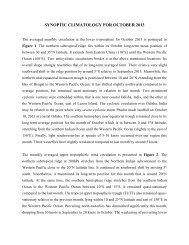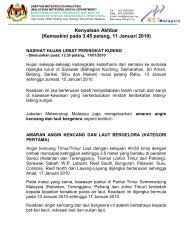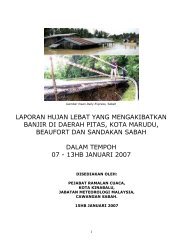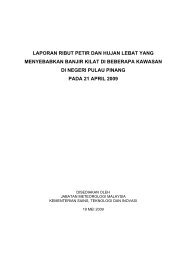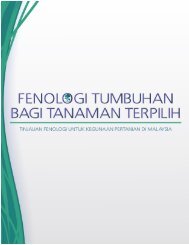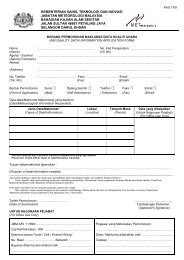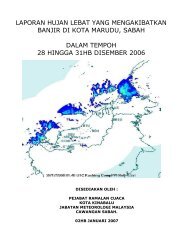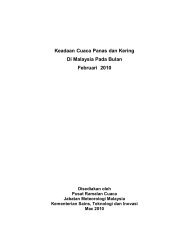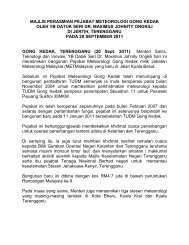Dr Salmah Zakaria FASc., Chair of ASM Climate Change and Water ...
Dr Salmah Zakaria FASc., Chair of ASM Climate Change and Water ...
Dr Salmah Zakaria FASc., Chair of ASM Climate Change and Water ...
You also want an ePaper? Increase the reach of your titles
YUMPU automatically turns print PDFs into web optimized ePapers that Google loves.
National Conference on Extreme Weather <strong>and</strong> <strong>Climate</strong> <strong>Change</strong>:Underst<strong>and</strong>ing Science <strong>and</strong> R & D Capacity Needs8-9 th October 2012, Auditorium Malaysian Meteorological Department<strong>Salmah</strong> <strong>Zakaria</strong>Fellow, <strong>ASM</strong>ESWRS/EDD ESCAPUNITED NATIONSESCAPEconomic <strong>and</strong> Social Commission for Asia <strong>and</strong> the Pacific
Table <strong>of</strong> Contents• Messages• <strong>Water</strong> Resources Challenges• The “Wicked Problem”
Messages• <strong>Climate</strong> <strong>Change</strong> Impact is happening• 93% <strong>of</strong> the impacts are water related• Current water related challenges will be exacerbated byclimate change impacts• <strong>ASM</strong> Task Force on CC Adaptation• Completed a status report on CC Impact• Some information are already available but more will beneeded, including new R&D findings• R&D required beyond climate change projection• Massive information to be managed coherently <strong>and</strong>effectively• Must look for possible alternatives/pathways to h<strong>and</strong>le thesemassive information
ESCAP develop AP Hot spots – base on 10Challenges from existing publications, 2009-10• Increasing <strong>Water</strong> Scarcity threat• High water utilization• Deteriorating water quality• Poor <strong>Water</strong> quality <strong>and</strong> low endowment• Flood Prone countries• Cyclone prone countries• <strong>Dr</strong>ought prone countries• Elevated ecosystem/climate change risks• Poor access to drinking water• Poor access to sanitation
<strong>Water</strong> Hot-spots(Source: UNESCAP, 2011)
AP Regional Challenges, 2011ESCAP preparation for 2APWS , 2013?• Population growth• Urbanization• Groundwater Depletion, Impact onAgriculture• Pollution <strong>of</strong> <strong>Water</strong> sources• Inadequate sanitation• Poor water quality – public healthconcerns• <strong>Water</strong> related disasters• <strong>Water</strong>-Food-Energy nexus• <strong>Water</strong> disputes
Chao Phraya RiversThail<strong>and</strong> = 513,120 km2Chao Phraya River Basin = 157,924 km 2Average Annual Rainfall = 1700mm•Whole <strong>of</strong> Chao Phrayaflood waters, passedthrough Bangkok•2011 Flood – lost <strong>and</strong>damage = USD45 Billion
Thai Flood 2011 - Damages <strong>and</strong> LossesSub SectorTotal (in Mn THB)Damage Losses TotalInfrastructure<strong>Water</strong> Resources Management (0.63%) 8,715 - 8,715Transport 22,878 6,263 29,141Telecommunication 1,290 2,020 3,309Electricity 3,191 5,321 8,512<strong>Water</strong> Supply <strong>and</strong> Sanitation (0.25%) 3,538 2,104 5,642Cultural Heritage 2,562 3,061 5,622ProductiveAgriculture, Livestock <strong>and</strong> Fishery (3.6%) 37,992 30,328 68,320Manufacturing (67% <strong>of</strong> total) 513,881 417,025 930,906Tourism (6.8%) 5,134 89,673 94,807Finance & Banking (8.3%) - 115,276 115,276SocialHealth 1,684 2,128 3,812Education 13,051 1,798 14,849Housing 45,908 52,807 98,715Cross CuttingEnvironment 375 176 551TOTAL 660,199 727,980 1,388,179
The River Basin
Singapore River BasinsArea <strong>of</strong> Singapore main isl<strong>and</strong> - 694 km 2Marina Basin – 1/5 <strong>of</strong> Singapore about 139 km 2Av Rainfall 2000mm/yrPopulation – 5.1 million (2012)Source: www.nea.gov.sg/cms/pcd/Management
Developing …..…to....now …. in the Marina Bay..from ..thenThe KallangRiver Basin
PUTRAJAYA WETLAND PARK• Introducing nature into the urban fabric• Man made wetl<strong>and</strong>s to act as a naturalfilter for lake water quality• Diverse habitats <strong>and</strong> plantsFrom: Perbadanan Putrajaya
PutrajayaMalaysia’s New Administrative Centre49 km sqPutrajaya Catchment, SgChuau Catchment, is atributary <strong>of</strong> Langat RiverSystemFrom: Perbadanan Putrajaya
From: Perbadanan Putrajaya
APWF Framework Document on <strong>Water</strong> <strong>and</strong><strong>Climate</strong> <strong>Change</strong> AdaptationFor Leaders <strong>and</strong> Policy-makers in the Asia-Pacific Region,2012• Focus on 5 principles• Principle 1 - Usable knowledge• Principle 2 – No regret Investments• Principle 3 - Resilience• Principle 4 – Mitigation <strong>and</strong> Adaptation• Principle 5 – Financing• Now looking at meta-guidelines for each principle
Findings in Capacity Gaps by <strong>ASM</strong>Study on the Status <strong>of</strong> <strong>Climate</strong> <strong>Change</strong> Impact on <strong>Water</strong> Related Issues- For <strong>ASM</strong> Task Force on <strong>Water</strong> <strong>and</strong> <strong>Climate</strong> <strong>Change</strong>, 2011• Challenges• Governance <strong>and</strong> Institutional Capacity• <strong>Climate</strong> <strong>Change</strong> Projections <strong>and</strong> R&D Capacity• Information Management Capacity• Stakeholders Awareness <strong>and</strong> Participation• Technical Management CapacityFrom: Lee Jin <strong>and</strong> Lavanya Iyer , 2011, Academy Science s <strong>of</strong> Malaysia
Challenges in Technical Management CapacityCase study – <strong>ASM</strong> Malaysia• <strong>Water</strong> Bodies Management Capacities• Rivers• Lakes• Aquifers• Coastal Areas• <strong>Water</strong> Use Management Capacities• Potable <strong>Water</strong> Supply• Agriculture & Irrigation <strong>Water</strong> Supply• Hydropower• Navigation• Fisheries• <strong>Water</strong> Ecosystems• Competing uses• <strong>Water</strong> Management Capacity• Floods• <strong>Water</strong> Pollution• <strong>Water</strong> Scarcity/<strong>Dr</strong>oughts• Human Health
<strong>ASM</strong> Case Study recommendations• Organize two levels <strong>of</strong> events• National Conference –• to create awareness among all the stakeholders on the key issues involved in water <strong>and</strong>climate change - completed• 7 thematic workshops• Governance <strong>and</strong> Institutional Capacity• <strong>Climate</strong> Projections <strong>and</strong> R&D Capacity• Information Management Capacity - completed• Stakeholder Awareness <strong>and</strong> Participation - completed• <strong>Water</strong> Bodies Management Capacity ?• <strong>Water</strong> Use Management Capacity ?• <strong>Water</strong> Management Capacity ?• Objectives <strong>of</strong> each thematic workshops• To agree on the key issues to be addressed in each theme to adapt to the impacts <strong>of</strong> climatechange on water,• To clarify, prioritise <strong>and</strong> define the strategic action plans <strong>and</strong> develop their list <strong>of</strong> activitiesto address each <strong>of</strong> the agreed issues.• To estimate the indicative costs, where possible, <strong>of</strong> each <strong>of</strong> the strategic action plan basedon their list <strong>of</strong> activities.
Information overload?• Too much information?• Multiple <strong>and</strong> competing users?• Too complex?• Opaque? – politics, private, communities• etc
H.G. Wells, The Brain: Organization<strong>of</strong> the Modern World , 1940• "An immense <strong>and</strong> ever-increasing wealth <strong>of</strong>knowledge is scattered about the world today;• knowledge that would probably suffice to solve allthe mighty difficulties <strong>of</strong> our age, but it is dispersed<strong>and</strong> unorganised.• We need a sort <strong>of</strong> mental clearing house: a depotwhere knowledge <strong>and</strong> ideas are received, sorted,summarized, digested, clarified <strong>and</strong> compared."
<strong>Water</strong> in <strong>Climate</strong> changed – a Wicked problem? Wicked problem - is ill-defined <strong>and</strong> connected to other intractableproblems. Common characteristics are problems that are dynamic(changing), systemic (interconnected) <strong>and</strong> generative (emergentissues <strong>and</strong> new dimensions). Therefore, there can be no final, optimal one-<strong>of</strong>f solution to it <strong>and</strong>solutions are not truly good or bad but “best that can be done”on a continuing basis as new dimensions <strong>and</strong> inter-relationshipsemerge. Because <strong>of</strong> inherent differences in governance, cultural,motivation <strong>and</strong> attitudes among stakeholders surrounding theproblem, resolution will require a new approach21
Wicked problems (Cont’d)• The persistent challenges caused by current practices <strong>and</strong>approaches thus constitute a complex problem with economicsocial-environmentalissues that had been termed “wickedproblems” (Rittel <strong>and</strong> Webber 1973 ).• Scientific solutions alone are unlikely to succeed in solvingsuch “wicked problems” because <strong>of</strong> the nature <strong>of</strong> the problemas much as the economic, societal <strong>and</strong> policy complexity inwhich it has to be resolved.• Scientific solutions can be developed for “tame” well definedproblems that can be solved in isolation, can be broken downinto parts which can be solved independently by differentgroups <strong>of</strong> people. Solutions to different parts <strong>of</strong> a largerproblem can then be integrated into an overall solution. Thesame does not hold true for “wicked” policy problems.22
Issues-Based Information System (IBIS)IssueMap(Evaluation)InformationRepository(ManagedInformation)• Identification <strong>of</strong> core issues, current efforts <strong>and</strong> risks• Generate ideas, options <strong>and</strong> solutions from synthesizedanalysis• Use the argumentation process to evaluate these ideas<strong>and</strong> solutions• Cluster <strong>and</strong> combine issues that are usually viewed inisolation• Accessible, usable <strong>and</strong> exploitable informationresources.• Information preprocessed into smaller unit <strong>of</strong>information to match information architecture• Combine, collate, <strong>and</strong> compare existing studies<strong>and</strong> analyze from multiple perspectivesOpen Information MarketInternet, DatabasesReports, Papers,Books(Unmanaged Information)3-Tier Information Management Structure• Covers information available in differentmedia <strong>and</strong> format• Includes policies, strategies, initiatives <strong>and</strong>studies on energy securityFrom: KK Aw
The Multicentric Information Framework <strong>and</strong> Mct-IBIS• LinkedIn <strong>and</strong> Facebook are dedicated relationshipmanagement system for pr<strong>of</strong>essional <strong>and</strong> socialrelationships.• The “Multicentric Information Framework” is ageneric information relationship management systemthat can be used to developed dedicated relationshipbased applications, in this case – Mct-IBIS• Mct-IBIS – an implementation <strong>of</strong> the IBIS methodologyusing the Multicentric Information Framework developedby Multicentric Technology.• Website - http://www.multicentric.com/wapi/mctweb.dll/getobject?objid=1&mid=MCTWebsite
If all you have is a hammer, then everything looks like a nail!Stakeholders have different perspectives <strong>of</strong> thebest solution to the problem & will continue toadhere strongly to them,
SL3 – <strong>Climate</strong> <strong>Change</strong> Projections <strong>and</strong>R&D capacity• All areas <strong>of</strong> R & D, with focus on “Technical ManagementCapacity”• What are the priorities?• Which line agencies should lead in each specific areas?• How can we create buy-ins from all stakeholders, so that wecan get support from policy/decision makers to enableallocations for human <strong>and</strong> financial resources?• What are the funds required?



